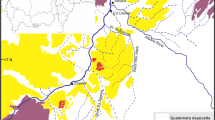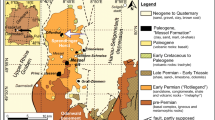Abstract
Canonical correlation analysis (CCA) is used in this study in order to trace the lineage of overbank sediment from the initial erosion of the parent rocks down to deposition of detrital material in alluvium of the small mountainous watersheds of the Žumberak area, Croatia. It helps to elucidate relations between the hierarchically structured systems (rocks, minerals, elements) represented by the ensembles of lithological, mineralogical and geochemical variables. Taking their place in the vertical order of hierarchical complexity, geochemistry and mineralogy of the recent material are considered dependent variable regarding the related watershed lithology, with geochemical variables (major and trace elements) last in the chain. Three canonical models are built and cross-compared in order to unravel the between-level relationships and infer the basic patterns of mineral and geochemical flux from the source rocks to basin. From these, the two hierarchical (provenance) chains epitomized in recombination of the first two canonical functions have been derived highlighting complementary provenances, weathering styles, and dispersion avenues in alluvial sedimentation of the study area. The first clearly separates carbonate from siliciclastic sedimentary source while the second illuminates the origin of phyllosilicate and ferric oxyhydroxide phases with associated suite of elements in absence of clear carbonate signal.







Similar content being viewed by others
References
Adriano DC (1986) Trace elements in the terrestrial environment. Springer, New York
Anscombe FJ (1960) Rejection of outliers. Technometrics 2:123–147
Bogen J, Bølviken B, Ottesen RT (1992) Environmental studies in Western Europe using overbank sediment. In: Bogen J, Walling DE, Day TJ (eds) Erosion and sediment transport monitoring programmes in river basins, vol 210. IAHS, Sheffield, pp 317–325
Bølviken B, Bogen J, Jartun M, Langedal M, Ottesen T, Volden T (2004) Overbank sediments:a natural bed blending sampling medium for large-scale geochemical mapping. Chemometr Intell Lab 74:183–199
Bonham-Carter GF, Rogers PJ, Ellwood DJ (1987) Catchment basin analysis applied to surficial geochemical data, Cobequid Highlands, Nova Scotia. J Geochem Explor 29:259–278
Bottrill LJ, Walling DE, Leeks GJL (1999) Geochemical characteristics of overbank deposits and their potential for determining suspended sediment provenance; an example from the River Severn, UK. In: Marriot SB, Alexander J (eds) Floodplains: interdisciplinary approaches, vol 163. Geological Soc Spec Publ, pp 241–257
Cappuyns V, Swennen R (2004) Secondary mobilization of heavy metals in overbank sediments. J Environ Monitor 6:434–440
Carranza EJM, Hale M (1997) A catchment basin approach to the analysis of reconnaissance geochemical-geological data from Albay Province, Philippines. J Geochem Explor 60:157–171
Chen JS, Wang FY, Li XD, Song JJ (2000) Geographical variations of trace elements in sediments of the major rivers in eastern China. Environ Geol 39:1334–1340
Collins AL, Walling DE (2002) Selecting fingerprint properties for discriminating potential suspended sediment sources in river basins. J Hydrol 261:218–244
Čović M (2003) Geochemical and mineralogical signatures of overbank sediments, Žumberak and Samoborsko Gorje, Croatia (in Croatian). Master Thesis, University of Zagreb
Croatian Geological Survey (2009) Geological map of the Republic of Croatia, Zagreb
Cullen WR, Reimer KJ (1989) Arsenic speciation in the environment. Chem Rev 89:713–764
De Vos W, Ebbing J, Hindel R, Schalich J, Swennen R, Van Keer I (1996) Geochemical mapping based on overbank sediments in the heavily industrialised border area of Belgium, Germany and the Netherlands. J Geochem Explor 56:91–104
Demetriades A (2008) Overbank sediment sampling in Greece: a contribution to the evaluation of methods for the ‘Global Geochemical Baselines’ mapping project. Geochem Explor Environ Anal 8:229–239
Dillon WR, Goldstein M (1984) Multivariate analysis: methods and applications. Wiley, New York
Ebisemiju FS (1988) Canonical correlation analysis in geomorphology with particular reference to drainage basin characteristics. Geomorphology 1:331–342
Esri Inc. (2009) ArcGIS (Data analysis Software System), Version 9.3.1. http://www.esri.com
Foster IDL, Charlesworth SM (1996) Heavy metals in the hydrological cycle: trends and explanation. Hydrol Process 10:227–261
González C, Quintana JR, Moreno L, Vázquez A, Lafuente AL, Romero A (2007) Applying multivariate methods to soil–solution interactions in carbonate media. Geoderma 137:352–359
Hair JF, Black WC, Babin BJ, Anderson RE (2009) Multivariate data analysis, 7th edn. Prentice Hall, Upper Saddle River
Halamić J, Peh Z (2009) Description of spatial distribution maps. In: Halamić J, Miko S (eds) Geochemical Atlas of the Republic of Croatia. Croatian Geological Survey, Zagreb, pp 30–85
Halamić J, Peh Z, Bukovec D, Miko S, Galović L (2001) A factor model of the relationship between stream sediment geochemistry and adjacent drainage basin lithology, Medvednica Mt, Croatia. Geol Croatica 54:37–51
Hovius N, Leeder M (1998) Clastic sediment supply to basins. Basin Res 10:1–5
Levinson AA (1974) Introduction to Exploration Geochemistry. Applied Publishing, Calgary
Macklin MG, Ridgway J, Passmore DG, Rumsby BT (1994) The use of overbank sediment for geochemical mapping and contamination assessment: results from selected English and Welsh floodplains. Appl Geochem 9:689–700
Matschullat J, Ottenstein R, Reimann C (2000) Geochemical background—can we calculate it? Environ Geol 39:990–1000
Mehra OP, Jackson ML (1960) Iron oxides removal from soils and clays by a dithionite-citrate-bicarbonate system buffered with sodium bicarbonate. 7th Nat Conf Clays Clay Miner 7:317–327
Muller KE (1981) Relationships between redundancy analysis, canonical correlation, and multivariate regression. Psychometrika 46:139–142
Nemes Z, Nagy NM, Komlósi A, Kónya J (2006) The effect of mineral composition on the interaction of strontium ions with geological formations. Appl Clay Sci 32:172–178
Ottesen RT (1987) Overbank deposits as a sampling medium in geochemical mapping. In: Wilhelm E (ed) Programme and Abstracts, 12th international geochemical exploration symposium. 4th symposium on methods of geochemical prospecting. Bureau de Recherches Géologiques et Miniéres. Orleans, p 178
Ottesen RT, Bogen J, Bølviken B, Volden T (1989) Overbank sediment: a representative sample medium for regional geochemical mapping. J Geochem Explor 32:257–277
Palinkaš LA, Borojević-Šoštarić S, Strmić-Palinkaš S, Prochaska W, Spangenberg J, Cuna S, Šinkovec B (2010) Permian-polysulphide-siderite-barite-haematite deposit Rude in Samoborska Gora Mts, Zagorje-Mid-Transdanubian zone of the Internal Dinarides. Geol Croatica 63:93–115
Palmer MR, Edmond JM (1992) Controls over the strontium isotope composition of river water. Geochim Cosmochim Ac 56:2099–2111
Pavelić D (2001) Tectonostratigraphic model for the North Croatian and North Bosnian sector of the Miocene Pannonian Basin System. Basin Res 12:359–376
Pedersen HD, Postma D, Jakobsen R (2006) Release of arsenic associated with the reduction and transformation of iron oxides. Geochim Cosmochim Ac 70:4116–4129
Peh Z, Miko S (2001) Geochemical comparison of stream and overbank sediments: a case study from the Žumberak Region, Croatia. Geol Croatica 54:119–130
Peh Z, Miko S, Mileusnić M (2006) Areal versus linear evaluation of relationship between drainage basin lithology and geochemistry of stream and overbank sediments in low-order mountainous drainage basins. Environ Geol 49:1102–1115
Peh Z, Šajn R, Halamić J, Galović L (2008) Multiple discriminant analysis of the Drava River alluvial plain sediments. Environ Geol 55:1519–1535
Prelogović E, Saftić B, Kuk V, Velić J, Dragaš M, Lučić D (1998) Tectonic activity in the Croatian part of the Pannonian basin. Tectonophysics 297:283–293
Pulkinnen E, Rissanen K (1997) A geochemical investigation of overbank sediments in the Inari are, northern Finnish Lapland. J Geochem Explor 59:11–26
Reimann C, Filzmoser P (2000) Normal and lognormal data distribution in geochemistry: death of a myth. Consequences for the statistical treatment of geochemical and environmental data. Environ Geol 39:1001–1014
Reimann C, Filzmoser P, Garret RG (2005) Background and threshold: critical comparison of methods of determination. Sci Total Environ 346:1–16
Rose AW, Dahlberg EC, Keith ML (1970) A multiple regression technique for adjusting background values in stream sediment geochemistry. Econ Geol 65:156–165
Salminen R, Tarvainen T, Demetriades A, Duris M, Fordyce FM, Gregorauskiene V, Kahelin H, Kivisilla J, Klaver G, Klin H, Larson JO, Lis J, Locutura J, Marsina K, Mjartanova H, Mouvet C, O’Connor P, Ódor L, Ottonello G, Paukola T, Plant JA, Reimann C, Schermann O, Siewers U, Steenfelt A, van der Sluys J, de Vivo B, Wiliams L (1998) FOREGS Geochemical mapping field manual guide 47. Geological Survey of Finland, Espoo
Schultz LG (1964) Quantitative interpretation of mineralogical composition from X-Ray and chemical data of the Pierre shales. Geol Surv Prof Paper 391C:1–31
Schwertmann U, Taylor RM (1989) Iron oxides. In: Dixon JB, Weed SB (eds) Minerals in soil environments, 2nd edn. Soil Sci Soc Am Book Series, pp 379–438
Šiftar D (1989) The age of evaporates and the origin of sulfate at Rude near Zagreb (in Croatian; English summary). Geol Vjesnik 42:59–64
Singh AK, Hasnain SI, Banerjee DK (1999) Grain size and geochemical partitioning of heavy metals in sediments of the Damodar River—a tributary of the lower Ganga. Environ Geol 39:90–98
Šinkovec B (1971) Geology of the iron and copper ore deposit at Rude near Samobor (in Croatian; English summary). Geol Vjesnik 24:165–181
Spadoni M (2006) Geochemical mapping using a geomorphologic approach based on catchments. J Geochem Explor 90:183–196
Spadoni M, Cavarretta G, Patera A (2004) Cartographic techniques for mapping the geochemical data of stream sediments: the “Sample Catchment Basin” approach. Environ Geol 45:593–599
StatSoft Inc. (2006) STATISTICA (Data Analysis Software System), Version 7.1. http://www.StatSoft.com
Stewart D, Love W (1968) A general canonical correlation index. Psychol Bull 70:160–163
Strahler AN (1957) Quantitative analysis of watershed geomorphology. Trans Am Geophys Union 38:913–920
Stutter MI, Langan SS, Lumsdon DG, Clark LM (2009) Multi-element signatures of stream sediments and sources under moderate to low flow conditions. Appl Geochem 24:800–809
Swennen R, van der Sluys J, Hindel R, Brusselmans A (2002) Geochemistry of overbank and high-order stream sediments in Belgium and Luxembourg: a way to assess environmental pollution. J Geochem Explor 62:67–79
Tari V, Pamić J (1998) Geodynamic evolution of the northern Dinarides and the southern part of the Pannonian Basin. Tectonophysics 297:269–281
Walling DE (2005) Tracing suspended sediment sources in catchments and river systems. Sci Total Environ 344:159–184
Webster R (1977) Canonical correlation in pedology—how useful. J Soil Sci 28:196–221
Wennrich R, Mattusch J, Morgenstern P, Freyer K, Treutler HC, Stärk HJ, Brüggemann L, Paschke A, Daus B, Weiss H (2004) Characterization of sediments in an abandoned mining area; a case study of Mansfeld region, Germany. Environ Geol 45:818–833
Wu J (1999) Hierarchy and scaling: extrapolating inf
Acknowledgments
This work was founded by the Ministry of Science, Education and Sports, Republic of Croatia (projects: 181-1811096-1104, The Map of Mineral Resources of the Republic of Croatia; 181-1811096-1181, The Basic eochemical Map of The Republic of Croatia, and 195-1953068-2704, Dinaric Karst: geological evolution, mineral raw materials, paleosols and soils). Their support is greatly appreciated.
Author information
Authors and Affiliations
Corresponding author
Rights and permissions
About this article
Cite this article
Peh, Z., Mileusnić, M. & Miko, S. Canonical correlation analysis as a tool in the provenance study of overbank sediments from the small mountainous watersheds. Environ Earth Sci 64, 1139–1155 (2011). https://doi.org/10.1007/s12665-011-0930-2
Received:
Accepted:
Published:
Issue Date:
DOI: https://doi.org/10.1007/s12665-011-0930-2




